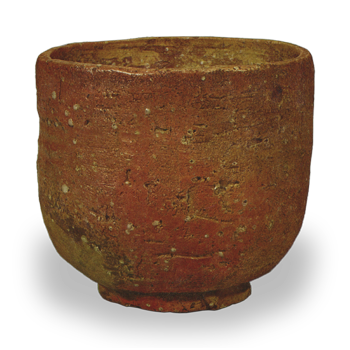


Accessories: Inner box, lid, inscription by Kakuzai Sōsai, outer box made of paulownia wood with lacquer finish
Provenance: Tsuda Sōyū—his son, Priest Kōgetsu—Fuyuki Kihachi during the Kansei period (1789–1800) Matsudaira Fumai—Nezu Aoyama
Recorded in: Senke Chūkyō Meibutsu Ki, Unshū Matsudaira-ke Hon Senke Denshiraku Meibutsu Ki, Fushimiya Kaku-sho, Ōsaki-sama Goto-dai Te-kō, Daien-an Chakai-ki, Taisho Meiki-kan
Dimensions
Height: 9.4 cm Mouth diameter: 9.8 cm Foot diameter: 5.0–6.0 cm Same height: 0.9 cm Weight: 415 g
Collection: Nezu Museum, Tokyo
This is a very fine tea bowl. It is well made and can be considered to have been made specifically as a tea bowl from the outset. The clay is Shigaraki clay, but the feldspar particles characteristic of Shigaraki clay have melted in the fire, giving it a texture reminiscent of melting ice or water.This feature caught the attention of tea masters, who recognized its rustic beauty and dubbed it “Mizuko” (Child of Water). As a tea bowl, it meets all the necessary criteria. Generally, Shigaraki and Bizen clays are not ideal for tea bowls. This is because both clays are characterized by their unglazed nature, and applying glaze would obscure their inherent qualities. Therefore, in the case of Shigaraki and Bizen, the clay is left unglazed to capture the changes in the flame.
Thus, they are unsuitable for tea bowls. In this regard, this tea bowl is truly remarkable. Crafted from clay that is inherently unsuitable for tea bowls, it demonstrates the exceptional skill of the potter and the discerning eye of the tea master who recognized its value.
It is a tea bowl that embodies the essence of wabi.



